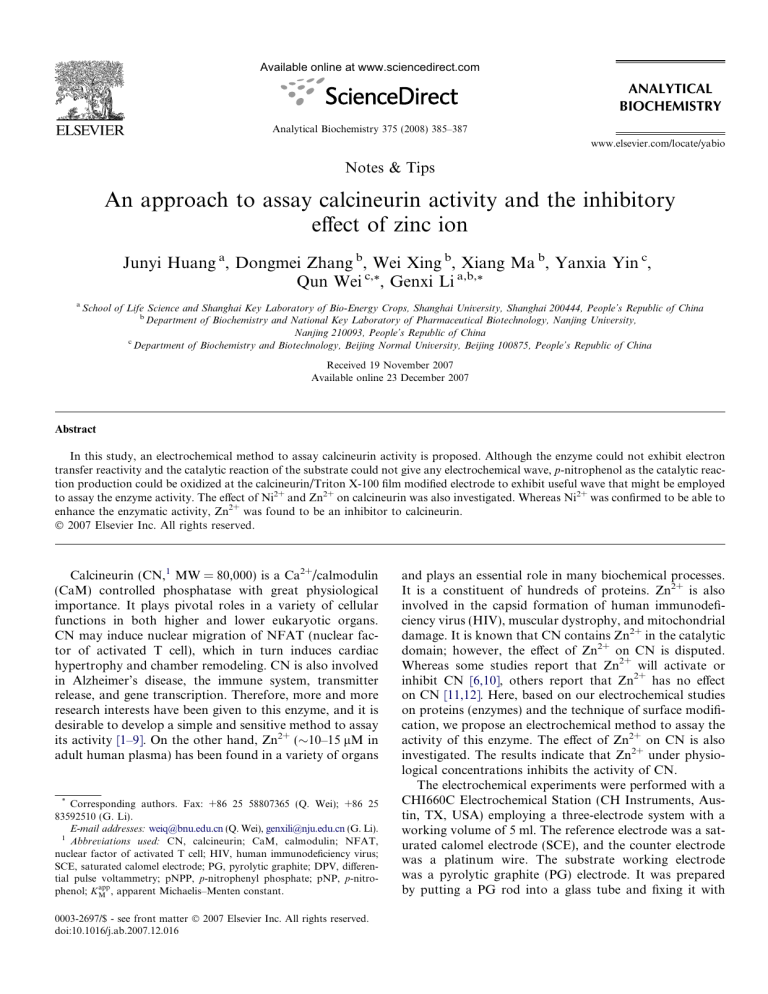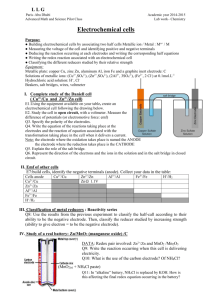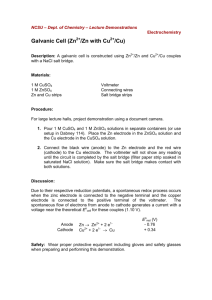(7) An approach to assay calcineurin activity and the inhibitory effect

Available online at www.sciencedirect.com
ANALYTICAL
BIOCHEMISTRY
Analytical Biochemistry 375 (2008) 385–387 www.elsevier.com/locate/yabio
Notes & Tips
An approach to assay calcineurin activity and the inhibitory effect of zinc ion
Junyi Huang
a
, Dongmei Zhang
b
, Wei Xing
Qun Wei
b c,*
, Genxi Li
, Xiang Ma
a,b,* b
, Yanxia Yin
c
,
a
School of Life Science and Shanghai Key Laboratory of Bio-Energy Crops, Shanghai University, Shanghai 200444, People’s Republic of China b
Department of Biochemistry and National Key Laboratory of Pharmaceutical Biotechnology, Nanjing University,
Nanjing 210093, People’s Republic of China c
Department of Biochemistry and Biotechnology, Beijing Normal University, Beijing 100875, People’s Republic of China
Received 19 November 2007
Available online 23 December 2007
Abstract
In this study, an electrochemical method to assay calcineurin activity is proposed. Although the enzyme could not exhibit electron transfer reactivity and the catalytic reaction of the substrate could not give any electrochemical wave, p -nitrophenol as the catalytic reaction production could be oxidized at the calcineurin/Triton X-100 film modified electrode to exhibit useful wave that might be employed to assay the enzyme activity. The effect of Ni
2+ and Zn
2+ on calcineurin was also investigated. Whereas Ni
2+ was confirmed to be able to enhance the enzymatic activity, Zn 2+ was found to be an inhibitor to calcineurin.
Ó 2007 Elsevier Inc. All rights reserved.
Calcineurin (CN,
MW = 80,000) is a Ca
2+
/calmodulin
(CaM) controlled phosphatase with great physiological importance. It plays pivotal roles in a variety of cellular functions in both higher and lower eukaryotic organs.
CN may induce nuclear migration of NFAT (nuclear factor of activated T cell), which in turn induces cardiac hypertrophy and chamber remodeling. CN is also involved in Alzheimer’s disease, the immune system, transmitter release, and gene transcription. Therefore, more and more research interests have been given to this enzyme, and it is desirable to develop a simple and sensitive method to assay its activity
. On the other hand, Zn
2+
( 10–15 l M in adult human plasma) has been found in a variety of organs
*
Corresponding authors. Fax: +86 25 58807365 (Q. Wei); +86 25
83592510 (G. Li).
E-mail addresses: weiq@bnu.edu.cn
(Q. Wei), genxili@nju.edu.cn
(G. Li).
1
Abbreviations used: CN, calcineurin; CaM, calmodulin; NFAT, nuclear factor of activated T cell; HIV, human immunodeficiency virus;
SCE, saturated calomel electrode; PG, pyrolytic graphite; DPV, differential pulse voltammetry; pNPP, p -nitrophenyl phosphate; pNP, p -nitrophenol; K app
M
, apparent Michaelis–Menten constant.
0003-2697/$ - see front matter Ó 2007 Elsevier Inc. All rights reserved.
doi:10.1016/j.ab.2007.12.016
and plays an essential role in many biochemical processes.
It is a constituent of hundreds of proteins. Zn
2+ is also involved in the capsid formation of human immunodeficiency virus (HIV), muscular dystrophy, and mitochondrial damage. It is known that CN contains Zn
2+ in the catalytic domain; however, the effect of Zn
2+
Whereas some studies report that Zn on CN is disputed.
2+ inhibit CN
, others report that Zn will activate or
2+ has no effect on CN
[11,12] . Here, based on our electrochemical studies
on proteins (enzymes) and the technique of surface modification, we propose an electrochemical method to assay the activity of this enzyme. The effect of Zn
2+ on CN is also investigated. The results indicate that Zn
2+ under physiological concentrations inhibits the activity of CN.
The electrochemical experiments were performed with a
CHI660C Electrochemical Station (CH Instruments, Austin, TX, USA) employing a three-electrode system with a working volume of 5 ml. The reference electrode was a saturated calomel electrode (SCE), and the counter electrode was a platinum wire. The substrate working electrode was a pyrolytic graphite (PG) electrode. It was prepared by putting a PG rod into a glass tube and fixing it with
386 epoxy resin. A copper wire was used to achieve electrical contact. The substrate PG electrode was first polished using rough and fine sandpapers. Then its surface was polished to mirror smoothness with an alumina (particle size
0.05
l m)/water slurry on silk. Finally, the electrode was thoroughly washed with both double-distilled water and ethanol in an ultrasonic bath for 5 min. After the pretreatment, the PG electrode could be modified by spreading a mixture of 10 l l of 10 mg/ml CN and 10 l l of 1% Triton X-100 onto its surface. The film on the PG surface should be dried overnight at room temperature ( 25 ° C). After being thoroughly rinsed with nanopure water, it was then ready for use. The supporting electrolyte was a 50-mM Tris–HCl buffer solution (pH 7.4). The potential range of differential pulse voltammetry (DPV) was between 0.6 and 1.2 V (vs. SCE) scanning in the positive direction. The electrode should be put in the test solution for 10 min before scanning.
As a protein phosphatase, CN can dephosphorylate p -nitrophenyl phosphate (pNPP) to p -nitrophenol (pNP) in vitro. However, besides the enzyme itself, both CN and pNPP are electrochemically silent, making it very difficult to measure this enzyme by using electrochemical methods.
Nevertheless, the catalytic reaction production, pNP, with a reductive hydroxyl can be oxidized, and it has been found that some interesting information can be obtained by making use of the electrochemical response of pNP.
As shown in
Fig. 1 , a well-defined peak can be observed
in the differential pulse voltammograms obtained at a CN/
Triton X-100 modified PG electrode for a Tris–HCl buffer solution (pH 7.4) containing 20 mM pNPP. The peak is located at 0.860 V (vs. SCE) scanning in the positive direction. If scanning in the negative direction, no peak of interest is observed. Therefore, pNP is irreversibly oxidized at the electrode surface.
also shows that no corresponding peak can be observed at either the bare PG electrode or the electrode modified with Triton X-100 alone. So, it is the enzymatic
Notes & Tips / Anal. Biochem. 375 (2008) 385–387 activity of CN that makes the catalytic dephosphorylation of pNPP to produce pNP, which is then oxidized to exhibit the observed peak in
. On the other hand, it should be noted that no peak can be observed if CN alone is deposited on the electrode surface (
C). So, Triton X-100, which has been used to provide a suitable environment for some proteins (enzymes) to maintain their natural activity
[13] , can also preserve the functional state of CN.
In fact, we tried many materials that are employed for protein electrochemistry (e.g., phosphatidylcholine, DNA, polyethyleneimine, kieselguhr) for this study. It was found that Triton X-100 is the best.
Further studies reveal that the observed oxidation peak of pNP can be related to the enzymatic activity of CN. This has been employed to show the activation of the enzymatic activity by exogenous metal ion, Ni
2+
. It is known that the activity of CN is very low in the absence of exogenous metal activator; however, CN can be activated remarkably by exogenous metal ion
. As shown in
matic activity increases sharply by Ni
2+ ranging from 0 to
0.8 mM, reaches the maximum at 1.0 mM, and then decreases. This is consistent with previous reports
.
The apparent Michaelis–Menten constant ð K app
M
Þ , which may give an indication of the enzyme–substrate kinetics, has also been calculated for the comparison of the enzymatic activity before and after CN is activated by Ni
2+ ion. Martin and coworkers reported that the K app
M of CN after the enzyme is activated by Ni
2+ is approximately
10 mM
. From our experimental results, we may obtain the K app
M value as 119 mM before its activation. As is well known, the higher the K ity. A high K app
M app
M
, the lower the enzymatic activvalue means low enzymatic activity, so the enzymatic activity of CN is very small before it is activated by Ni
2+ ion.
Spectrophotometry is the commonly used method to determine CN activity, but it is difficult to display the activity of CN without activation.
also show that
Fig. 1. Differential pulse voltammograms obtained at bare PG electrode
(a), Triton X-100 modified electrode (b), CN modified electrode (c), and
CN/Triton X-100 modified electrode (d) in a 50-mM Tris–HCl buffer solution (pH 7.4) containing 20 mM pNPP. Scan rate: 50 mV/s.
Fig. 2. Dependence of the peak current on Ni
2+ experimental conditions are the same as in
concentration. Other
Notes & Tips / Anal. Biochem. 375 (2008) 385–387
References the electrochemical wave is high enough to be observed even if the enzyme has not been activated by Ni
2+ ion, so this proposed method is more sensitive to assay the activity of CN. Also, it is very convenient and simple with good precision in addition to the advantages of electrochemical technique.
Among the effects of the metal ions, the role of Zn
2+ in the regulation of CN remains to be elucidated, and some inconsistent results have been reported
. So, we have especially studied the effect of Zn
2+ on CN. Experimental results reveal that the obtained peak will decrease if Zn
2+ is involved in this system and that the peak current will become smaller with the increase of the concentration of Zn
2+
. Approximately 33% activity will be inhibited with
0.5
l M Zn
2+
, and 3.0
l M Zn
2+ will inhibit nearly all of the activity of CN. So, it is obvious that Zn
2+ will inhibit the activity of CN. Meanwhile, it is known that under physiological concentrations of Zn
2+
(in the range of 10–15 l M), no activity of CN remains and it is possible for cells to regulate CN activity by changing the cytosolic concentration of Zn
2+
. On the other hand, because CN plays an important role in some signal transduction pathways, Zn
2+ may participate in the elaborate regulation of signal transduction through behaving as an inhibitor of CN in vivo.
In summary, we have proposed an electrochemical method to assay the enzymatic activity of CN and studied the effect of Ni
2+ and Zn
2+ ions on this enzyme. It was confirmed that Ni
2+ can enhance the enzymatic activity of the enzyme, whereas Zn
2+ should be an inhibitor. Within the physiological concentration range of this ion, CN will exhibit no activity and cells can easily regulate CN activity by changing the Zn
2+ concentration. This work also provided an approach to study the proteins (enzymes) with no electrochemical activities, so more important proteins may be studied by using the electrochemical technique described in this report.
Acknowledgments
This work was supported by the National Natural Science Foundation of China (90406005, 20575028) and the
Program for New Century Excellent Talents in University, the Chinese Ministry of Education (NCET-04-0452).
387
[1] H.G. Wang, N. Pathan, I.M. Ethell, S. Krajewski, Y. Yamaguchi, F.
Shibasaki, F. McKeon, T. Bobo, T.F. Franke, J.C. Reed, Ca
2+
induced apoptosis through calcineurin dephosphorylation of BAD,
Science 284 (1999) 339–343.
[2] J.E. Miskin, C.C. Abrams, L.C. Goatley, L.K. Dixon, A viral mechanism for inhibition of the cellular phosphatase calcineurin,
Science 281 (1998) 562–565.
[3] Z. Xia, D.R. Storm, The role of calmodulin as a signal integrator for synaptic plasticity, Nat. Rev. Neurosci. 6 (2005) 267–276.
[4] E. Takimoto, H.C. Champion, M. Li, D. Belardi, S. Ren, E.R.
Rodriguez, D. Bedja, K.L. Gabrielson, Y. Wang, D.A. Kass, Chronic inhibition of cyclic GMP phosphodiesterase 5A prevents and reverses cardiac hypertrophy, Nat. Med. 11 (2005) 214–222.
[5] C.R. Kissinger, H.E. Parge, D.R. Knighton, C.T. Lewis, L.A.
Pelletier, A. Tempczyk, V.J. Kalish, K.D. Tucker, R.E. Showalter,
E.W. Moomaw, L.N. Gastinel, N. Habuka, X. Chen, F. Maldonado,
J.E. Barker, R. Bacquet, J.E. Villafranca, Crystal structures of human calcineurin and the human FKBP12–FK506–calcineurin complex,
Nature 378 (1995) 641–644.
[6] K. Takahashi, E. Akaishi, Y. Abe, R. Ishikawa, S. Tanaka, K.
Hosaka, Y. Kubohara, Zinc inhibits calcineurin activity in vitro by competing with nickel, Biochem. Biophys. Res. Commun. 307 (2003)
64–68.
[7] C.J. Pallen, J.H. Wang, Calmodulin-stimulated dephosphorylation of p -nitrophenyl phosphate and free phosphotyrosine by calcineurin,
J. Biol. Chem. 258 (1983) 550–553.
[8] D.A. Fruman, C.B. Klee, B.E. Bierer, S.J. Burakoff, Calcineurin phosphatase activity in T lymphocytes is inhibited by FK506 and cyclosporine, Proc. Natl. Acad. Sci. USA 89 (1992) 686–
690.
[9] A. Enz, G. Shapiro, A. Chappuis, A. Dattler, Nonradioactive assay for protein phosphatase 2B (calcineurin) activity using a partial sequence of the subunit of cAMP-dependent protein kinase as substrate, Anal. Biochem. 216 (1994) 147–153.
[10] M.H. Krinks, A.S. Manalan, C.B. Klee, Calcineurin: A calmodulin regulated protein phosphatase, Fed. Proc. 42 (1983) 2026.
[11] H.C. Li, W.S. Chan, Activation of brain calcineurin towards proteins containing Thr(P) and Ser(P) by Ca
2+
, calmodulin, Mg
2+
, and transition metals, Eur. J. Biochem. 144 (1984) 447–452.
[12] M.M. King, C.Y. Huang, Activation of calcineurin by nickel ions,
Biochem. Biophys. Res. Commun. 114 (1983) 955–961.
[13] X. Liu, Y. Xu, X. Ma, G. Li, A third-generation hydrogen peroxide biosensor fabricated with hemoglobin and Triton X-100, Sens.
Actuat. B 106 (2005) 284–288.
[14] B.L. Martin, D.J. Rhode, Effect of substitution inert metal complexes on calcineurin, Arch. Biochem. Biophys. 366 (1999) 168–176.
[15] Y.L. Qin, D.Y. Yu, Q. Wei, Function and structure of recombinant single chain calcineurin, Biochem. Biophys. Res. Commun. 308 (2003)
87–93.




